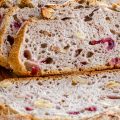In a world filled with bread lovers, you’ll discover a variety of delicious bread at every corner. Since sourdough is one of the healthiest and most flavorful bread out there, it only seems fitting to experiment with a variety of flavors, to make this crisp loaf increasingly phenomenal. From sweet to savory, there’s no limit to amplifying your favorite baked bread. And if you’re a fan of bread and a lover of olives, then why not combine your love of the two, and create something utterly drool-worthy? Have a go at this scrumptious olive sourdough bread recipe!
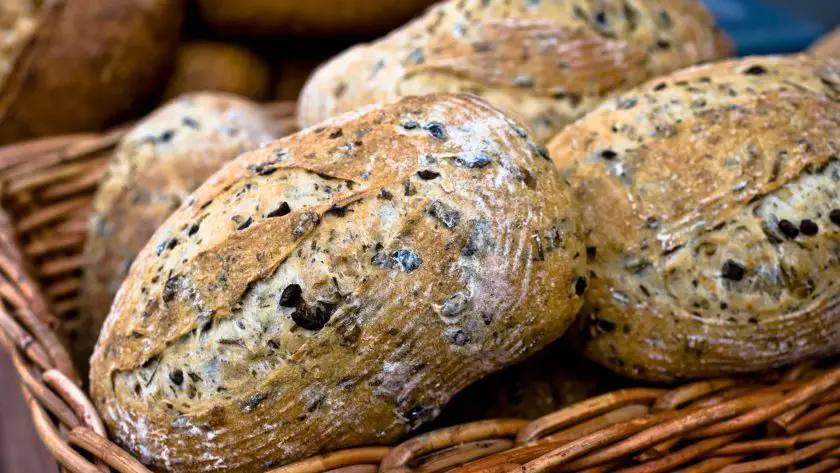
Table of Contents
- What is Olive Bread?
- How to Make Sourdough Olive Bread
- Best Olives to Put in Sourdough Bread
- How to Serve Olive Sourdough?
- More Sourdough Bread Recipes
- Delicious Sourdough Olive Bread
- FAQs
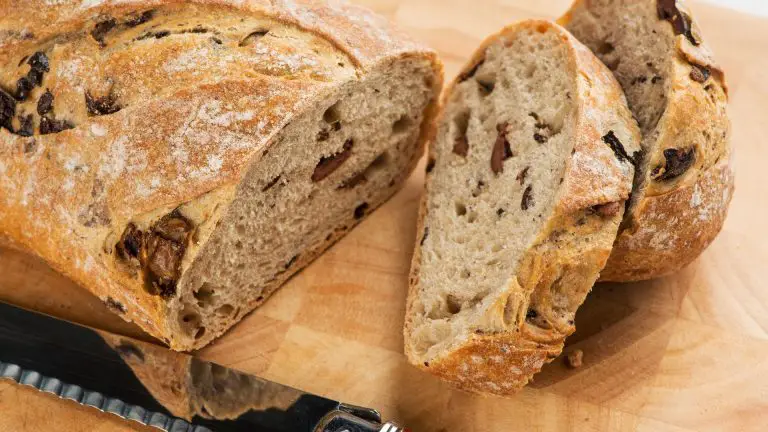
Sourdough Olive Bread Recipe
- Total Time: 50 minutes
- Yield: 1 loaf 1x
Ingredients
- 300g unbleached bread flour
- 140g wheat or whole wheat flour
- 360g filtered water
- 90g ripe sourdough starter
- 9g kosher salt or fine sea salt
- 75g pitted castelvetrano olives (sliced in half)
- 75g pitted kalamata olives
- White rice flour
Instructions
- Prepare the autolyze: In a large bowl, add bread flour, and whole wheat flour, followed by 350g of water, and mix till thoroughly combined. Cover the bowl with plastic wrap and allow this to rest at room temperature for 1.5 hours. This is a crucial step, as it hydrated the flour, and helps build a good dough structure.
- Add starter and rest: Add the remaining 10g of water along with 90g of ripe sourdough starter. Use your fingers to gently smear the starter over the autolyzed mixture. Fold the edges of the dough into the center, then use your thumb and fingers to roughly pinch the dough until the mixture is perfectly incorporated. Cover and rest for 30 minutes.
- Add salt: Sprinkle 9g of kosher or fine sea salt over the surface of the dough. Use your fingers to pinch and absorb the salt into the dough. Ensure that you cannot see or feel any grains of salt at the end of mixing. This step should take around 5 minutes. Cover and rest for 15 minutes before the initial stretch and folds.
- Bulk fermentation: During this 45-minute bulk fermentation, you’ll need to perform 3 sets of stretches and folds at 15-minute intervals. Cover the dough and let it rest between each set.
- Add the olives: After the third set, cover and let the dough rest for 30 minutes. Spray your work surface with water and gently transfer your dough onto a work surface or kitchen countertop. Using both hands, gently grab and stretch the dough, to form a thin rectangular shape. The dough should be able to withstand rough stretching without tearing. Layer several pitted and halved olives across the surface of the dough. Fold the dough and shape it into a loose ball, before transferring this into a bowl.
- Bulk fermentation: Allow the dough to rest for 45 minutes, then it’s time to perform two coil folds. Using both hands, lift the dough from the center, allow each end to stretch, then fold the dough beneath itself. Repeat the process, rotating the bowl as your fold. Cover and rest between each fold. Then cover the dough and allow it to rest for 2 hours. The dough should double in size, with a few bubbles decorating its surface,
- Pre-shape: Transfer the dough onto a clean countertop. Use a bench knife to shape the dough into a smooth rounded shape. Pull the dough towards you, to help create some surface tension. Rest the dough for 15 to 20 minutes uncovered.
- Final shape: Dust a proofing basketwith rice flour, then sprinkle some bread flour onto the surface of the dough. Use a bench knife to gently lift and flip the dough flour side-down onto your work surface. Shape the dough into a round, or oval, depending on the shape of your basket. Lift the shaped dough, and transfer the dough to the pre-prepped proofing basket.
- Final proof: Cover and refrigerate for 16 hours. This is called cold fermentation and helps the dough develop unique flavors, as well as improves the final crust texture.
- Preheat the oven: Preheat a Dutch oven, in a 500 degrees F oven for 1 hour.
- Bake: Once your baking vessel and oven have preheated, remove the proofing basket from the fridge. Uncover the dough, and carefully place this into your hot Dutch oven. Score the shaped dough with a sharp razor blade. Bake the olive sourdough bread with the lid on for 25 minutes. Then remove the lid and reduce the temperature to 475 degrees F; bake for another 25 minutes, until the crust achieves a wonderful golden brown color.
- Transfer the baked loaf to a cooling rack and let this cool completely before slicing.
Notes
- For this recipe, you’ll require an active and ripe sourdough starter.
- Look out for those tiny stretching bubbles decorating the starter’s surface before you begin!
- Cook Time: 50 mins
- Category: bread
What is Olive Bread?
Generally, olive bread refers to a loaf of bread encased with whole or chopped olives. This produces a wonderful and unique artisan bread flavor.
However, when you take an olive bread recipe and include a sourdough starter, you achieve the best of both worlds!
Is Olive Bread Healthy?
Olive bread is certainly healthy, especially when baked in a Dutch oven. Since olives are loaded with heart-healthy fats and your sourdough starter is brimming with good bacteria, you’ll quickly produce a delicious and nutritious loaf for you and your family to enjoy!
How to Make Sourdough Olive Bread
For this recipe, you’ll require an active and ripe sourdough starter. Look out for those tiny stretching bubbles decorating the starter’s surface before you begin!
Take a look at the mouthwatering recipe below:
Ingredients
- 300g unbleached bread flour
- 140g wheat or whole wheat flour
- 360g filtered water
- 90g ripe sourdough starter
- 9g kosher salt or fine sea salt
- 75g pitted castelvetrano olives (sliced in half)
- 75g pitted kalamata olives
- White rice flour
Instructions
- Prepare the autolyze: In a large bowl, add bread flour, and whole wheat flour, followed by 350g of water, and mix till thoroughly combined. Cover the bowl with plastic wrap and allow this to rest at room temperature for 1.5 hours. This is a crucial step, as it hydrated the flour, and helps build a good dough structure.
- Add starter and rest: Add the remaining 10g of water along with 90g of ripe sourdough starter. Use your fingers to gently smear the starter over the autolyzed mixture. Fold the edges of the dough into the center, then use your thumb and fingers to roughly pinch the dough until the mixture is perfectly incorporated. Cover and rest for 30 minutes.
- Add salt: Sprinkle 9g of kosher or fine sea salt over the surface of the dough. Use your fingers to pinch and absorb the salt into the dough. Ensure that you cannot see or feel any grains of salt at the end of mixing. This step should take around 5 minutes. Cover and rest for 15 minutes before the initial stretch and folds.
- Bulk fermentation: During this 45-minute bulk fermentation, you’ll need to perform 3 sets of stretches and folds at 15-minute intervals. Cover the dough and let it rest between each set.
- Add the olives: After the third set, cover and let the dough rest for 30 minutes. Spray your work surface with water and gently transfer your dough onto a work surface or kitchen countertop. Using both hands, gently grab and stretch the dough, to form a thin rectangular shape. The dough should be able to withstand rough stretching without tearing. Layer several pitted and halved olives across the surface of the dough. Fold the dough and shape it into a loose ball, before transferring this into a bowl.
- Bulk fermentation: Allow the dough to rest for 45 minutes, then it’s time to perform two coil folds. Using both hands, lift the dough from the center, allow each end to stretch, then fold the dough beneath itself. Repeat the process, rotating the bowl as your fold. Cover and rest between each fold. Then cover the dough and allow it to rest for 2 hours. The dough should double in size, with a few bubbles decorating its surface,
- Pre-shape: Transfer the dough onto a clean countertop. Use a bench knife to shape the dough into a smooth rounded shape. Pull the dough towards you, to help create some surface tension. Rest the dough for 15 to 20 minutes uncovered.
- Final shape: Dust a proofing basket with rice flour, then sprinkle some bread flour onto the surface of the dough. Use a bench knife to gently lift and flip the dough flour side-down onto your work surface. Shape the dough into a round, or oval, depending on the shape of your basket. Lift the shaped dough, and transfer the dough to the pre-prepped proofing basket.
- Final proof: Cover and refrigerate for 16 hours. This is called cold fermentation and helps the dough develop unique flavors, as well as improves the final crust texture.
- Preheat the oven: Preheat a Dutch oven, in a 500F oven for 1 hour.
- Bake: Once your baking vessel and oven have preheated, remove the proofing basket from the fridge. Uncover the dough, and carefully place this into your hot Dutch oven. Score the shaped dough with a sharp razor blade. Bake the olive sourdough bread with the lid on for 25 minutes. Then remove the lid and reduce the temperature to 475F; bake for another 25 minutes, until the crust achieves a wonderful golden brown color.
- Transfer the baked loaf to a cooling rack and let this cool completely before slicing. Check out how to cut sourdough bread for more insight!
Best Olives to Put in Sourdough Bread
For this scrumptious sourdough olive bread recipe, you can use any kind of olive you desire. There is no right or wrong way around it! For this particular loaf, I have chosen kalamata, and castelvetrano olives. However, you can choose from:
- Green olives
- Pimento olives
- Black olives
Additional Flavors That Compliment Olive Sourdough Bread
The race to incorporate a bunch of flavorful additions to your sourdough olive bread recipe is nothing but incredible. Especially when you’ve managed to produce a wonderful-tasting loaf. Here are some ideas for you to consider:
- Olive cheese bread: Add 1 cup of shredded cheddar to your dough with the olives.
- Green olive bread: Replace kalamata olives with chopped green olives.
- Olive and herb bread: Add 1 tablespoon of dried thyme, and oregano to your dry ingredients.
- Olive garlic sourdough bread: Add 1 teaspoon of garlic powder to the dry ingredients.
- Black olive bread: Replace the kalamata olives with black olives.
- Sun-dried tomato and olive bread: Add 1 cup of sliced sun-dried tomatoes.
- Rosemary olive sourdough bread: Add 2 teaspoons of dried rosemary.
- Walnut olive sourdough bread: Add 1 cup of chopped and toasted walnuts.
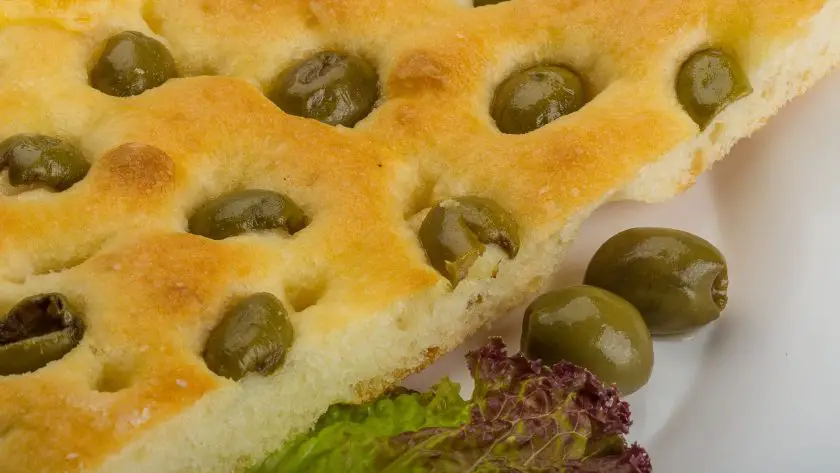
How to Serve Olive Sourdough?
Sourdough bread enhanced with olives sounds incredibly appetizing. When you combine sourdough’s natural tartness with the rich sourness of the olives, you create a fascinating loaf that can be devoured with almost anything you can imagine! So why not choose a delicious bunch of sides that will only complement these unique flavors even further?
Here are some ideas for you to try
- Scrambled egg bread
- Cheesy French toast
- Italian Panzanella
- French onion soup
- Veggie stew
Scrambled Egg Bread
You may have heard of scrambled eggs and bread for breakfast, so why not combine the two to make a decadent treat?
Simply crack and whisk your eggs in a bowl. Then dunk your sliced olive bread into the scrambled eggs and drop them into a greased cast iron skillet. Fry the egg-soaked bread on both sides, till they’re crisp and ready to devour.
Cheesy French Toast
Ever tried cheesy French toast with sourdough olive bread? The taste is blissfully extraordinary. You can serve this for breakfast or brunch for your family!
Spread some of your favorite jam on one side of the bread, and sprinkle the other side with cheese. Dip the bread in some pre-whisked eggs, and drop this into a pan to fry. Though the mix of ingredients may sound odd, this cheesy French toast will definitely delight your taste buds!
Italian Panzanella
If you’re looking for ways to spice up your salad dishes, then this delicious Panzanella is calling your name.
Slice your favorite salad ingredients, from juicy tomatoes to briny olives. Crumple a handful of feta cheese, and finish with a drizzle of vinegar. Serve this delightful treat with slices of olive sourdough bread, and enjoy!
On the subject of Italian dishes, you can also use your sourdough olive bread to mop up the delicious sauce in this Tuscan smothered pork chops recipe!
French Onion Soup
Olives and onions make quite the combination, in terms of flavor and aroma. So why not take this opportunity to incorporate these wonderful flavors in French onion soup? The rich flavors of the onions will complement the olive-dotted sourdough bread beautifully. You can even break your sourdough bread into tiny little pieces and drop them into the onion soup for ultimate satisfaction!
Veggie Stew
If you’re not a particular fan of heavy meat-based stews, then why not try a veggie stew?
Having stew on its own may become a tad overpowering, but when paired with delicious olive sourdough olive bread you have a gorgeous treat! The olive bread will absorb the fabulous flavors of the stew, as well as provide hearty flavors with each bite.
More Sourdough Bread Recipes
Sourdough bread is super versatile. Once you’ve used your sourdough starter to create the best loaf to date, you’ll only want to experiment some more! Have you tried sourdough discard recipes? Dive into some of these delectable sourdough bread recipes below!
- Sourdough discard sandwich bread
- Sourdough naan
- Sourdough breadsticks
- Sourdough flatbread
Sourdough Discard Sandwich Bread
Too much discard? No problem. Try this delicious sourdough discard sandwich bread recipe.
You’ll need 75g of sourdough discard and a pinch of instant yeast to speed up the process. Add your favorite sandwich fillings to the mix and you’re all set for a week of scrumptious lunchtime sandwiches!
Sourdough Naan
Homemade naan is great for any dinner occasion, so why not make your very own sourdough naan instead?
You’ll need a cast iron skillet, an active sourdough starter, and lots of yogurt for this recipe. Yogurt is a key ingredient in every naan recipe, it’s what creates an ultra-silky softness that doesn’t go undetected.
Sourdough Breadsticks
When you’re tired of making sourdough loaves, it’s time to make some breadsticks! This sourdough breadsticks recipe is super simple and incredibly delicious. Perfect for dunking into your favorite dips!
- You’ll need dry herbs, sesame seeds, salt, extra virgin oil, a sourdough discard or starter, and flour.
- Drop your dry ingredients into a large bowl, then add olive oil and sourdough discard mixing thoroughly.
- Knead the dough and let it rest for 10 minutes. Divide the dough into equal pieces, and shape each piece into a cylinder.
- Coat these dough sticks in your choice of flavorings.
- Transfer the breadsticks to a tray lined with parchment paper, then loosely cover and proof at room temperature for 2 hours.
- Bake at 320 degrees F till dry and crisp like a cracker.
- Then find your favorite sauce to dip and enjoy!
Sourdough Flatbread
A flatbread is a type of thin bread that is great for filling with meats and veggies. While this is an incredibly delicious way to appreciate a variety of flavors, the inclusion of a sourdough starter discard will only amplify this meal further.
- For this sourdough flatbread recipe, you’ll need a discarded starter, flour, milk, and yogurt.
- Simply add your ingredients in a bowl, and combine using your hands.
- Cover the dough with a plastic wrap and let this rest for 12 hours.
- Then shape your dough, and cook these in a cast iron skillet over medium high heat for 15 minutes.
- Serve with your choice of meat or veggies for the ultimate feast!
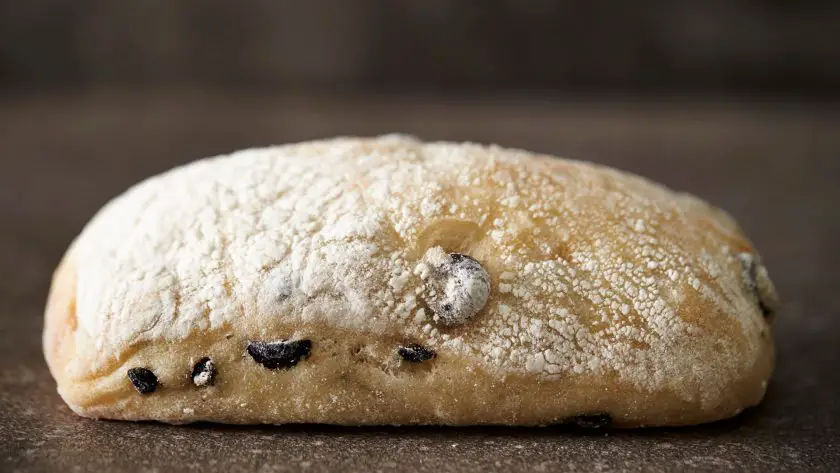
Delicious Sourdough Olive Bread
There’s no limit to the deliciousness provided by sourdough bread. So why not get creative and produce a bunch of unique and flavorful treats for you and your family to enjoy!
FAQs
Is Olive Sourdough Bread Healthy?
Olive sourdough bread contains high levels of vitamins, minerals, and antioxidants compared to regular bread. It also contains lower levels of phytate, therefore ensuring your body absorbs the nutrients it contains compared to regular bread.
What Does Olive Oil Do to Sourdough Bread?
Adding olive oil to sourdough bread will result in a flavorful loaf, softer crust, and crumb.
Is Sourdough Bread the Healthiest?
When compared to regular white bread, sourdough bread is considered the healthiest bread, as it contains higher levels of vitamins and minerals.
Are Sourdough Breads Healthy?
Since your sourdough loaves are brimming with beneficial nutrients, it is super-beneficial to your diet; improving gut health, and blood sugar levels.



